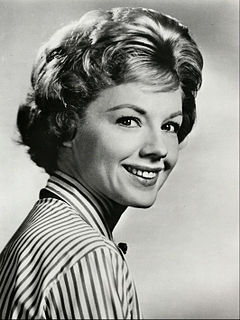
Mary Virginia Martin was an American actress and singer. A muse of Rodgers and Hammerstein, she originated many leading roles on stage over her career, including Nellie Forbush in South Pacific (1949), the title character in Peter Pan (1954), and Maria von Trapp in The Sound of Music (1959). She was named a Kennedy Center Honoree in 1989. She was the mother of actor Larry Hagman.

The King and I is the fifth musical by the team of Rodgers and Hammerstein. It is based on Margaret Landon's novel, Anna and the King of Siam (1944), which is in turn derived from the memoirs of Anna Leonowens, governess to the children of King Mongkut of Siam in the early 1860s. The musical's plot relates the experiences of Anna, a British schoolteacher who is hired as part of the King's drive to modernize his country. The relationship between the King and Anna is marked by conflict through much of the piece, as well as by a love to which neither can admit. The musical premiered on March 29, 1951, at Broadway's St. James Theatre. It ran for nearly three years, making it the fourth-longest-running Broadway musical in history at the time, and has had many tours and revivals.

Ethel Merman was an American actress and singer. Known for her distinctive, powerful voice, and for leading roles in musical theatre, she has been called "the undisputed First Lady of the musical comedy stage". Over her distinguished career in theater she became known for her performances in shows such as Anything Goes, Annie Get Your Gun, Gypsy, and Hello, Dolly!

Annie Get Your Gun is a musical with lyrics and music by Irving Berlin and a book by Dorothy Fields and her brother Herbert Fields. The story is a fictionalized version of the life of Annie Oakley (1860–1926), a sharpshooter who starred in Buffalo Bill's Wild West, and her romance with sharpshooter Frank E. Butler (1847–1926).

Call Me Madam is a musical written by Howard Lindsay and Russel Crouse, with music and lyrics by Irving Berlin.
Lindsay and Crouse was the writing team of Howard Lindsay and Russel Crouse, who collaborated famously on a succession of Broadway plays and musicals for 27 years during the mid 20th century. Their first collaboration was the rewriting of the book for the Cole Porter musical Anything Goes in 1935. They continued to co-pen books for Broadway musicals through 1962, including Rodgers and Hammerstein's The Sound of Music in 1959. They also penned several successful comedies; notably winning the Pulitzer Prize for Drama in 1945 for their original play State of the Union. Several of their works were adapted into motion pictures. The team also co-produced the original production of Arsenic and Old Lace by playwright Joseph Kesselring.
"I Got Rhythm" is a piece composed by George Gershwin with lyrics by Ira Gershwin and published in 1930, which became a jazz standard. Its chord progression, known as the "rhythm changes", is the foundation for many other popular jazz tunes such as Charlie Parker's and Dizzy Gillespie's bebop standard "Anthropology ".

Virginia Gibson was an American dancer, singer and actress of film, television and musical theatre.
"Mutual Admiration Society" is a popular song published in 1956 from the Broadway musical Happy Hunting. The song's tune was written by Harold Karr, the lyrics by Matt Dubey.
"Everything's Coming Up Roses" is a song with music by Jule Styne and lyrics by Stephen Sondheim, written initially for the 1959 Broadway musical Gypsy. Introduced in the show's inaugural production by Ethel Merman, "Everything's Coming Up Roses" became one of Merman's signature songs.
Irene Sharaff was an American costume designer for stage and screen. Her work earned her five Academy Awards and a Tony Award. Sharaff is universally recognized as one of the greatest costume designers of all time.

Hallelujah, Baby! is a musical with music by Jule Styne, lyrics by Adolph Green and Betty Comden, and a book by Arthur Laurents. The show is "a chronicle of the African American struggle for equality during the [first half of the] 20th century."
Florence Klotz was an American costume designer on Broadway and on film.

Red, Hot and Blue is a stage musical with music and lyrics by Cole Porter and a book by Howard Lindsay and Russel Crouse. It premiered on Broadway in 1936 and introduced the popular song "It's De-Lovely," sung by Ethel Merman and Bob Hope.
Something for the Boys is a musical with music and lyrics by Cole Porter and a book by Herbert Fields and Dorothy Fields. Produced by Mike Todd, the show opened on Broadway in 1943 and starred Ethel Merman in her fifth Cole Porter musical.

Shangri-La is a musical with a book and lyrics by James Hilton, Jerome Lawrence, and Robert E. Lee and music by Harry Warren.
Patricia Zipprodt was an American costume designer. She was known for her technique of painting fabrics and thoroughly researching a project's subject matter, especially when it was a period piece. During a career that spanned four decades, she worked with such Broadway theatre legends as Jerome Robbins, Harold Prince, Gower Champion, David Merrick, and Bob Fosse.
The 26th Annual Tony Awards was broadcast by ABC television on April 23, 1972, from The Broadway Theatre in New York City. Hosts were Henry Fonda, Deborah Kerr and Peter Ustinov.
Raoul Pene Du Bois was an American costume designer and scenic designer for the stage and film. He was nominated for two Academy Awards in the category Best Art Direction.

Call Me Madam is a 1953 American Technicolor musical film directed by Walter Lang, with songs by Irving Berlin, based on the 1950 stage musical of the same name.










